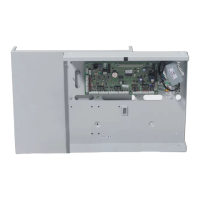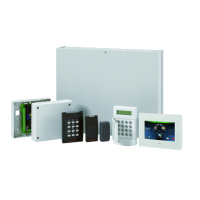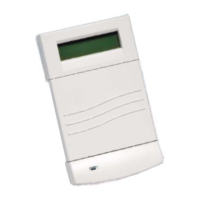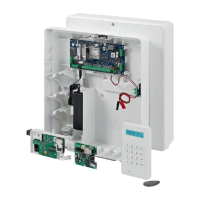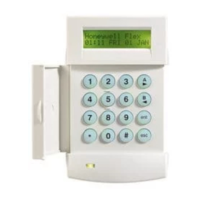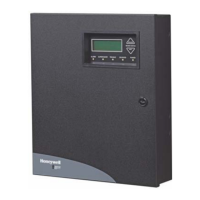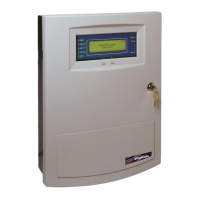5
Access Control
Door Control Modules (DCMs) can be added onto the
Galaxy bus lines to add fully integrated access control.
Each DCM allows two Wiegand readers to be connected to
control two separate doors or one door with an entry and
exit reader.
Group based Access control
Access control works best when Group Mode is enabled
(see above). Each access reader can then be programmed
to control access to a particular group (or area/subsystem)
within the building. Only users who have access privileges
to that group will be granted access via that reader.
Users and Access Templates
Every user on the system must be allocated an access
template. An access template is a list of groups and time
schedules that will dictate which groups and when a user
is able to gain access to. This method means that if there
are multiple doors leading into one group or area, then a
user will be given access to all those doors in one move.
This reduces programming time and complexity.
The Access Template to be used for each user is chosen
within each user’s options in menu 42.1.11 = Template.
There are multiple access templates available (dependant
on panel variant) and each one is fully customisable.
Access Templates are programmed in menu
45.7 = Access Templates. In each Access Template each
group on the system must be allocated a time schedule as
required. If no schedule is allocated to a particular group
(default) in the list then users will have full access through
any doors leading to that group. When a schedule is
allocated, access will be granted during the OFF periods of
the schedule and denied during the ON periods. Time
schedules are programmed in menu 65 = Timers.
Time schedules
A Time schedule is a weekly list of on and off times and
can be used to control the security of any object that it is
assigned to. When a timer is ON it forces a secure state
(system set, access denied etc). When a timer is in the
OFF state, it causes an un-secure state (system unset or
access allowed etc). Up to 28 on or off times can be
programmed into each weekly schedule. Up to 67
schedules are available dependant on panel variant.
For each time schedule, it is possible to allocate one of 32
Holiday Calendars. A Holiday Calendar is a list of 20
holiday periods, each with a start and end date, which
suspend normal timer operation. During a holiday period,
one of two things can happen.
1. The timer is frozen in its current state (on or off)
and will resume operation from the next event
when the holiday period finishes.
2. An alternate time schedule can be appointed to be
used for the duration of the holiday period.
Panel Specifications
Mechanical
All variants
Enclosure
(with PCB and transformer) Width: 440 mm
Height: 325 mm
Depth: 88 mm
Weight: 6.4 kg
Physical space for batteries 2x17Ah Max
(not suitable for 12Ah batteries)
PCB only Width: 265 mm
Height: 120 mm
Depth: 47 mm
Weight: 0.3 kg
Operating Temperature: -10
o
C to +55
o
C
Electrical
GD-48 GD-96 GD-264/520
Mains Input: 230 V ac (+10%, -15%) @ 50 Hz
Power Supply: Type A
Battery Type Sealed Lead-Acid (not included)
Max ripple voltage 50.0 mV
Max Current rating* 0.5A 1A 1A
Minimum standby battery capacity required for Max load:
EN50131 @ 30 hrs 21Ah 30Ah 30Ah
PD6662 @ 12 hrs 8.4Ah 12Ah 12Ah
Total PSU output 2.5A 2.5A 2.5A
Aux +12 V outputs: 12 V nominal
Fuses – all 20 mm Anti-surge
AUX1 1.0A 1.0 A 1.0 A
AUX2 - 1.0 A 1.0 A
BELL 1.0A 1.0 A 1.0 A
BATT 1.0A 1.6 A 1.6 A
*Ratings for EN50131 Grade 3 – Max total +12V output load including
Bell output load.
PSTN V.22 Modem 1200 Baud
RS232 300 – 56k programmable
RS485 9600 Baud, Full Duplex, Asynchronous
EN50131 Compliance
This product is suitable for use in systems designed to comply with
TS50131-3
Security Grade: 3
Environmental Class: II
Power Supply Type: A
The built-in Telecom module is for Remote servicing use only on Grade
3 systems. An external Grade 3 communicator or Ethernet module must
be used for alarm signalling.
The built-in Telecom module can be used for alarm signalling on Grade 2
systems:
Alarm Transmission System: 2
(options A, B, C & X)
This product is suitable for use in systems designed to comply with
EN50131-1: 1997
Security Grade: 2
Environmental Class: II
Alarm Transmission System: 2
(options D2, T2, A2, S0, I0)
Power Supply Type: A

